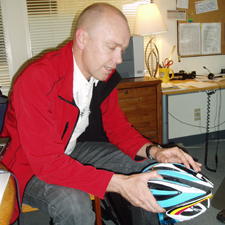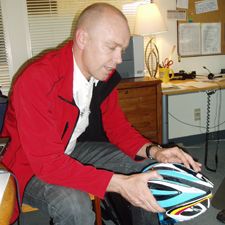Lazer may not be a familiar helmet brand in the U.S. market, where Bell and Giro dominate, but it is the Bell or Giro of Europe, said Sean van Waes, manager of the bicycle division for Lazer Helmets, while visiting the BRAIN offices in late February.
Lazer, a Belgian designer and manufacturer of bicycle, motorcycle and leisure helmets, has been in business since 1919. The founders named the company Cross—the English translation of their family name—but in 1980 changed the commercial name to Lazer to sound more edgy.
The company made its first hard-shell bicycle helmet in 1987, developed in collaboration with Eddy Merckx. It gradually transitioned to the in-mold helmets it makes today.
Although the company has European manufacturing facilities for motorcycle helmets, it outsources its bicycle helmets to one of four factories in Dongguan and Shenzhen, China. Van Waes said much handwork goes into the top-of-the-line Helium helmet, which has six separate pieces. Each helmet takes 2 hours and 15 minutes to make.
But Van Waes said what really sets Lazer helmets apart is its patented Rollsys fit system, which surrounds the head completely. By turning a smooth thumb wheel on top of the helmet, the Rollsys system adjusts the peripheral sizing with a Jagwire cable. The helmet is symmetrically tightened to shape to the form of your head, Van Waes said.
The helmets also have a unique roll cage, which is made of plastic or carbon fiber, for additional impact protection.
Van Waes said in Europe, the company’s competition is not other helmet makers but people. He said Europeans don’t like to wear helmets because they perceive them as for amateurs. But he said that perception is changing as more pro racers are seen wearing helmets.
Here in the States, the company faces a much different challenge. While QBP has distributed the brand for the past six years, it’s still small a small player in the crowded U.S. helmet market. Michael Pederson, Lazer product manager at QBP, said last year Lazer sales doubled. And with more than 160 U.S. dealers at the end of last year, the brand still has plenty of room to grow. “We have to find little cracks and go after them,” Pederson said.
He said although the retail trend toward concept stores and heavy commitments has meant that dealers dedicate more of their purchasing dollars to key brands, concept stores pose some opportunities for premium brands. Lazer’s high-end helmets nicely complement entry-level Trek helmets, he said.
Pederson said Lazer is also trying to open new doors by allowing dealers to buy in small quantities. According to Pederson, dealers are tired of the heavy-handed tactics of some suppliers and obligatory pre-season orders.
He said in this economy, as dealers are watching their stock more carefully, the opportunity to buy Lazer helmets in small quantities and place fill-in orders makes sense.

Sean van Waes demonstrates how the Lazer helmet is not that "mushroomy" compared to most helmets.


